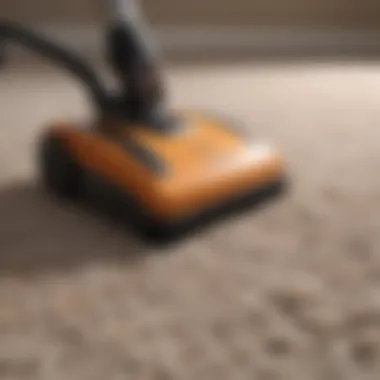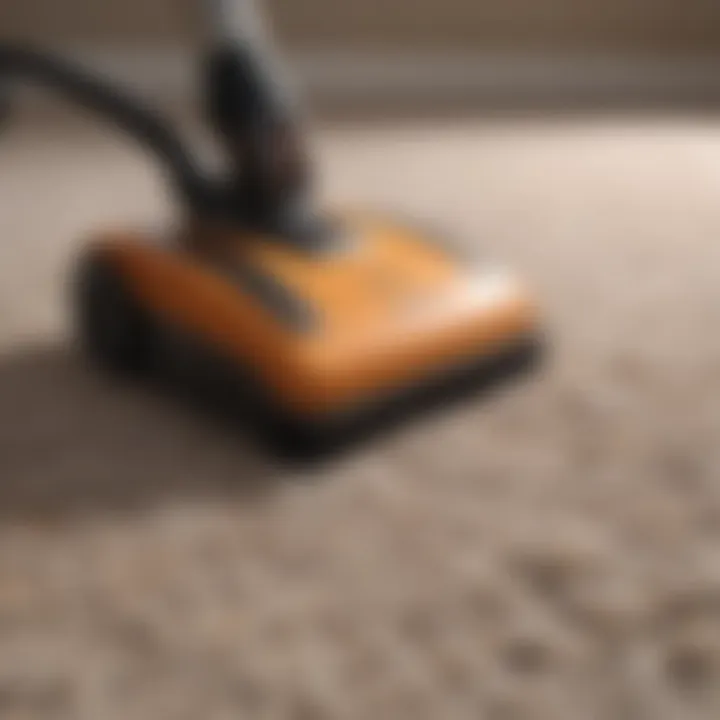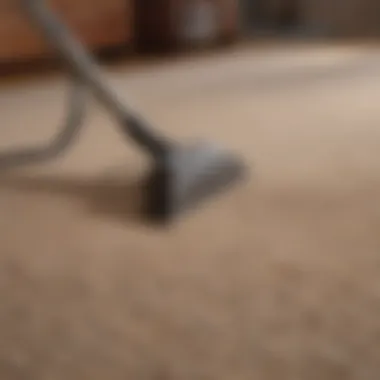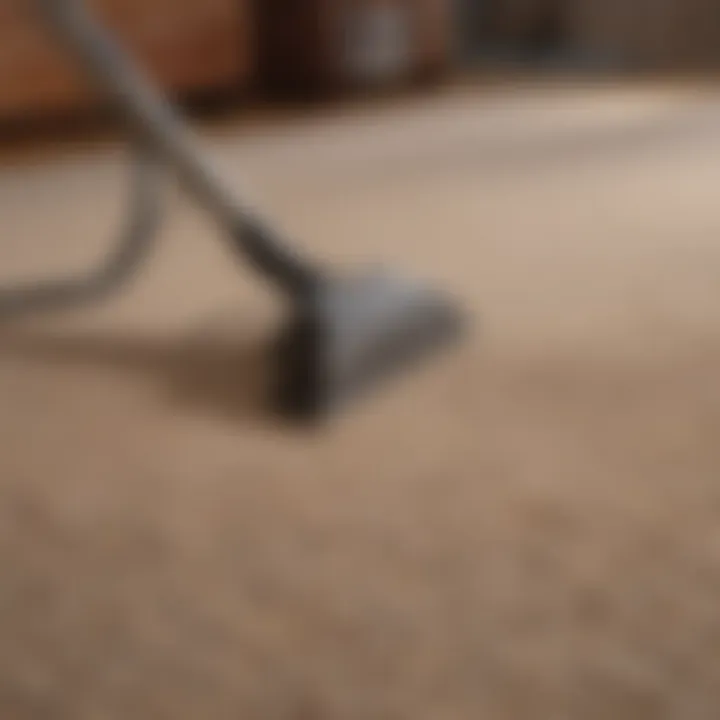Effective Methods to Remove Stubborn Carpet Stains


Intro
When it comes to carpet care, understanding the nature of the stains is vital. Certain substances, like red wine or pet urine, require specific approaches for optimal results. As we progress through the sections, we will delve deeper into an array of cleaning methods that can benefit your carpet's condition.
Whether you are a homeowner looking to preserve investments or a rental property manager maintaining quality, the methods discussed will offer valuable insights. Let us begin this comprehensive journey into effective carpet cleaning techniques.
Preamble to Carpet Cleaning
Carpet cleaning is a topic that warrants attention due to its impact on both aesthetics and hygiene. Stains and dirt accumulate over time, often unnoticed until their presence becomes a glaring issue. The importance of proper carpet maintenance is not just about keeping a room looking good. It goes deeper into aspects of health and indoor air quality. Grime, allergens, and bacteria can become trapped in carpet fibers, leading to potential health hazards. Therefore, understanding the basic principles of carpet cleaning can help mitigate these risks and preserve the integrity of your flooring.
Regular carpet cleaning can also extend the lifespan of carpets, which is a significant investment in any space. By learning effective methods for cleaning, individuals can avoid costly replacements. Moreover, it contributes to a more pleasant environment. When carpets are clean, the overall atmosphere of a home improves, enhancing comfort and aesthetics.
One must consider various factors when engaging with carpet cleaning. The material of the carpet, types of stains, and the cleaning solutions used all play critical roles in achieving the desired results. For example, synthetic carpets may respond differently to natural solutions compared to wool carpets. Understanding these dynamics can lead to more effective cleaning strategies.
In essence, this article aims to equip readers with the knowledge required for effective carpet maintenance. By exploring comprehensive methods for tackling stubborn stains and offering insights into tools and solutions, we empower individuals to take control of their carpet care. This knowledge not only alleviates immediate cleaning concerns but also contributes to the long-term quality of one’s living space.
Understanding Different Types of Carpet Stains
Understanding the different types of carpet stains is crucial for effective cleaning. Each stain type has unique properties and requires specific methods for removal. Knowing the distinctions between stains allows homeowners to tailor their cleaning approaches. This knowledge not only enhances the effectiveness of the cleaning process but also helps prevent potential damage to the carpet fibers. The following sections will delve into various common stain categories, providing insights into their characteristics and removal techniques.
Food and Beverage Stains
Food and beverage stains are among the most common issues faced by homeowners. Spills from items like coffee, wine, sauces, and juices can quickly set into carpets if not addressed promptly. To effectively remove these types of stains, it is essential to act fast. Begin with blotting the area to absorb excess liquid. A mixture of warm water and a few drops of dish soap can be effective. Avoid scrubbing, as this can spread the stain further into the fibers. Instead, dab the solution on the stain and blot it with a clean cloth until the stain lifts.
Pet-Related Stains
Pets can contribute significantly to carpet stains, from urine to food spills. Addressing these stains promptly is essential to avoid lingering odors and discoloration. For pet urine, start by blotting the area with paper towels to absorb as much liquid as possible. An enzyme cleaner specialized for pet stains can help break down any remaining particles, reducing odors while cleaning. It's advisable to rinse the area with cool water after applying any cleaning solution, and then blot again to absorb moisture.
Ink and Paint Stains
Ink and paint stains are notoriously difficult but not impossible to remove. For ink stains, a solution of rubbing alcohol can be beneficial. Apply a small amount on a clean cloth and gently dab at the stain, working from the outside toward the center. This method helps prevent spreading. For paint, the approach depends on whether it is water-based or oil-based. Water-based paint can often be cleaned with warm, soapy water. In contrast, oil-based paint may require a solvent like mineral spirits for successful removal. Always test cleaning solutions on a hidden area of the carpet before full application to ensure colorfastness.
Grease and Oil Stains
Grease and oil stains can come from various sources, including cooking oils or automotive products. These stains require specific treatment due to their viscous nature. Start by sprinkling a generous amount of talcum powder or cornstarch on the stain. Let it sit for at least 30 minutes to absorb the grease. Afterward, vacuum the area thoroughly. Follow up with a mixture of liquid dish soap and warm water applied with a sponge. Blot the area consistently until the stain is lifted, rinsing with a clean, damp cloth afterward to remove any residue. This method is essential for preserving the carpet's integrity.
"The key to effective stain removal is acting quickly and using the right techniques for each type of stain."
In summary, understanding the characteristics of different carpet stains is the first step towards successful removal. By using appropriate methods tailored to each stain type, homeowners can maintain their carpets’ appearance and prolong their lifespan. Each type of stain presents unique challenges, but with informed techniques, they can be managed effectively.
Essential Tools and Materials for Carpet Cleaning
Carpet cleaning is not just about employing a cleaning solution and scrubbing the stains away. To achieve effective results, essential tools and materials are crucial. They facilitate the cleaning process and improve the overall outcomes. By using the right products, you can minimize damage to the carpet and ensure a longer lifespan for your flooring. Understanding the importance of these items allows one to approach carpet stains more strategically.
Cleaning Solutions
Cleaning solutions come in various formulations, designed to tackle specific stain types. While household cleaners may provide some relief, it is often beneficial to invest in specialized carpet cleaners. These solutions penetrate deep into the fibers, breaking down stains more effectively than generic alternatives.


Key considerations when choosing cleaning solutions:
- Stain Type: Different stains require different treatments. For example, water-based stains like soda may need a different approach than oil-based stains from grease.
- Carpet Material: Synthetic fibers typically respond well to many cleaning solutions, while natural fibers like wool may require gentler products.
- Eco-Friendly Options: With increasing awareness of environmental issues, many now prefer biodegradable cleaning solutions. These options are safer for children and pets.
Application Tools
The right application tools are just as important as the cleaning solutions themselves. They help apply the cleaners thoroughly and consistently. Invest in these common application tools:
- Spray Bottles: Useful for distributing cleaning solutions evenly on the stained area.
- Soft Brush or Cloth: A soft-bristle brush can help work the cleaner into the carpet fibers without causing damage. Microfiber cloths also work well for blotting stains.
- Wet/Dry Vacuum: Extremely effective for rinsing and extracting cleaning solutions post-application, minimizing residue left behind.
Protective Gear
When engaging in carpet cleaning, using protective gear is key to keeping oneself safe and ensuring optimum efficacy. Not all cleaning solutions are safe for skin or inhalation.
- Gloves: Wearing rubber or latex gloves protects your hands from harsh chemicals.
- Masks: For certain cleaning products that emit strong fumes, masks can offer necessary protection from inhaling potentially harmful substances.
- Knee Pads: If you find yourself kneeling to scrub or apply cleaners, knee pads can make the task more comfortable.
Taking the time to gather these essential tools and materials prepares you for a thorough and effective carpet cleaning process. Proper preparation is a step toward achieving satisfying results.
Pre-Cleaning Considerations
Before embarking on the process of cleaning stubborn carpet stains, it is crucial to understand the pre-cleaning considerations that set the groundwork for effective stain removal. This preparatory phase can significantly influence the success of your efforts, ensuring that both the correct techniques and cleaning products are applied.
Importance of Pre-Cleaning Considerations
Pre-cleaning considerations include identifying the type of carpet material and testing any cleaning solutions. These steps are not merely an afterthought; they are vital in ensuring that the cleaning process does not inadvertently damage the carpet or result in ineffective stain removal.
Understanding the carpet material helps to determine which cleaning methods and solutions are appropriate. Some materials, such as natural fibers like wool, require gentle handling, while synthetic fibers can often withstand more aggressive cleaning methods. Thus, knowing the specifics of your carpet’s fabric can save time and preserve its integrity.
"Identifying your carpet material is not just a technical step; it's the key to achieving a balance between cleanliness and material preservation."
Moreover, testing the cleaning solutions on a small inconspicuous area ensures that there are no adverse reactions. Some chemicals may cause bleeding of colors or degradation of fibers. Therefore, this simple yet effective method mitigates the risk of damaging the entire carpet, allowing you to proceed confidently.
Identifying Carpet Material
Before you proceed with any cleaning, start by identifying the carpet material. Carpets can be made from various materials including nylon, polyester, wool, and cotton. Each of these materials responds differently to cleaning agents. For instance:
- Nylon: This is durable and stain-resistant, making it easier to clean. However, it can be sensitive to high heat.
- Polyester: Usually stain-resistant too, but it may be prone to crushing or matting under heavy traffic.
- Wool: While luxurious and resilient, wool is susceptible to water damage and shrinkage if cleaned with too much moisture or inappropriate chemicals.
- Cotton: Natural fiber that can be more absorbent, which may lead to easier staining but also requires careful handling.
To identify your carpet material, check the tags that often accompany carpets or consult the seller if possible. If unsure, perform a simple burn test on a small fiber sample. The way it burns can help determine the material.
Testing Cleaning Solutions
Once the carpet material is known, the next step is testing the cleaning solution. This process is straightforward but essential. Select a small, non-visible area of the carpet, such as a corner or behind furniture. Apply a small amount of the cleaning solution, allowing it to sit for a few minutes. After, blot it with a white cloth to see if any color transfers.
Key points for testing cleaning solutions are:
- Check for discoloration: If the tested area shows any sign of color change or fading, that solution is likely unsafe for your entire carpet.
- Consider fiber reactions: Different fibers react uniquely. For example, wool may absorb too much moisture compared to synthetic fibers, leading to potential damage.
- Test multiple solutions if needed: It is prudent to try a few options to see which performs best without compromising the carpet’s quality.
In summary, taking the time for pre-cleaning considerations can lead to a much more effective and safer carpet cleaning process. Understanding the type of carpet you are dealing with and testing cleaning solutions can save you from costly mistakes and help achieve the best results.


Step-by-Step Cleaning Process
The Step-by-Step Cleaning Process is imperative in ensuring an effective approach to removing stubborn carpet stains. This structured method allows individuals to systematically address each stain without risking further damage to the carpet fibers. Following a defined process enables a thorough application of techniques and cleaning solutions, maximizing the chances of success in stain removal while preserving the integrity of the carpet.
Several benefits arise from adhering to a step-by-step method. First, it helps identify the nature of the stain and determines the respective cleaning technique required. Secondly, this approach reduces the likelihood of spreading the stain, a common mistake when attempting to remove stubborn marks. Also, it ensures a more even application of cleaning solutions, preventing unevenness and discoloration post-treatment. Lastly, understanding each step empowers the user to make informed decisions throughout the cleaning process, contributing to a more satisfying and effective outcome.
Initial Blotting Technique
Starting with the Initial Blotting Technique is critical. This method involves using a clean, absorbent cloth or paper towel to gently blot the stain. The goal is to soak up as much of the liquid or residue as possible without rubbing it in.
Key points about this technique include:
- Avoid Rubbing: Rubbing can push the stain deeper into the fibers, making it harder to remove.
- Dab, Don't Wipe: Dabbing motion collects moisture rather than spreading it.
- Use the Right Cloth: Ensure your cloth is free from dye and chemicals to avoid introducing new stains.
This technique should be the first action taken for any type of stain, whether it is from food, drinks, or pets. This simple yet effective initial step sets the stage for successful removal.
Applying Cleaning Solutions
Once the initial blotting is done, the next crucial step involves Applying Cleaning Solutions. The choice of cleaning solution depends on the stain type; for instance, a diluted vinegar solution often works well for food stains, while enzyme-based cleaners are better suited for pet-related stains.
When applying the cleaning solution, consider the following:
- Test the Solution: Always perform a patch test in an inconspicuous area of the carpet to confirm that it does not cause discoloration.
- Use a Spray Bottle: This allows for an even application, ensuring that the solution penetrates the stain adequately.
- Follow Instructions: Different products have specific instructions for the best results, which are essential to follow for effective cleaning.
Scrubbing Techniques
The Scrubbing Techniques employed depend largely on the carpet fiber. Some carpets require a gentle touch, while others may withstand heavier scrubbing. It is important to choose the appropriate tool for the job, whether it's a soft-bristle brush or an old toothbrush.
Consider these techniques:
- Circular Motion: Scrubbing in small, circular motions helps lift the stain upward rather than pushing it deeper.
- Limit over-Scrubbing: Over-scrubbing can damage the carpet fibers and create a worn appearance.
- Combine Techniques: Sometimes combining blotting and scrubbing can yield better results, especially for tougher stains.
Rinsing and Drying
Finally, the Rinsing and Drying part must be handled with care. This step ensures that all cleaning residue is removed from the carpet, which is vital to prevent attracting dirt in the future.
Here are some tips for effective rinsing and drying:
- Use Clean Water: Rinse with clear water using a clean cloth or spray bottle.
- Blot Dry: After rinsing, continue blotting with a dry cloth to absorb excess moisture.
- Air Circulation: Allow the carpet to air dry completely. Open windows or use fans to speed up the process, avoiding mold or odors.
Dealing with Persistent Stains
Persistent stains can be one of the most exasperating challenges for carpet owners. They do not just affect the carpet's visual appeal; they can also compromise the integrity of the fibers. Understanding how to effectively deal with these types of stains is crucial for maintaining a fresh and clean living environment. This section focuses on advanced techniques and the option of professional help, which are essential when home remedies fail.
By exploring these methods, readers gain insight into both DIY solutions and when to seek outside assistance. The goal is to extend the life of your carpet while ensuring your home remains inviting and comfortable.
Advanced Cleaning Methods for Tough Stains


When faced with tough stains, some typical household cleaning methods may prove inadequate. Instead, certain advanced cleaning methods may be required, tailored to the specific type of stain.
Some effective techniques include:
- Steam Cleaning: Utilizing high-pressure steam can help penetrate deep into the fibers of the carpet, loosening up stubborn stains. This is particularly effective for organic stains such as food or beverages.
- Enzyme-Based Cleaners: These specialized cleaners employ enzymes that break down proteins in stains, making them easier to remove. They are especially useful for pet-related stains where urine and feces can result in lingering odors.
- Hydrogen Peroxide Treatment: For ink or paint stains, hydrogen peroxide can serve as a powerful yet gentle cleaning agent, lifting the color from the fiber without damaging the carpet.
- Amino-Based Products: Designed for grease and oil stains, these products can break down tough buildup. This method often involves a combination of blotting and applying the product directly onto the stain.
Each method requires a some period of testing to ensure carpet compatibility, particularly when using strong chemicals.
Professional Carpet Cleaning Options
Sometimes, do-it-yourself methods may not yield the desired results. In such cases, hiring a professional cleaning service can be a wise choice. Professional carpet cleaners possess specialized equipment and expertise that can effectively engage stubborn stains.
Here are some options offered by professionals:
- Hot Water Extraction: This method uses hot water mixed with cleaning agents, which is injected into the carpet fibers under high pressure. This process effectively removes both dirt and stains.
- Dry Cleaning: In situations where moisture could cause further issues, dry cleaning may be preferred. This technique uses non-water based solvents to clean carpets while avoiding oversaturation.
- Specialized Stain Removal Services: Many professional cleaners offer targeted treatment for specific types of stains, ensuring the best possible outcome without damage to the carpet.
Hiring professionals can provide both immediate and long-term benefits by not only resolving stubborn stains but also helping to rejuvenate carpet fibers.
In summary, addressing persistent stains requires understanding advanced cleaning methods as well as knowing when to consult professionals. Ignoring these stains can lead to deeper issues, making proactive measures important for carpet longevity.
In engaging with these methods, carpet owners are better prepared to handle the inevitable mishaps that come with everyday use.
Prevention Strategies for Future Stains
Implementing effective prevention strategies holds a pivotal role in maintaining the appearance and longevity of carpets. Understanding how stains occur and adopting proactive measures can significantly reduce the frequency and severity of carpet staining. These strategies not only save time but also lessen the need for aggressive cleaning methods that can harm the fibers over time. Investing in prevention pays off in the long term, enhancing both the aesthetic appeal of your space and the durability of your carpet.
Regular Maintenance Tips
Maintaining clean carpets requires consistent effort. Here are some essential maintenance tips:
- Vacuum Regularly: Frequent vacuuming removes dirt and particles that can get embedded in the fibers. Aim for at least once a week in low-traffic areas, and more often in high-traffic zones.
- Spot Clean Immediately: When spills occur, it is vital to address them right away. Blot the area gently with a soft cloth to absorb as much liquid as possible. Avoid rubbing, as it can push the stain deeper into the carpet.
- Use Doormats: Place mats at entry points to trap dirt and debris before they reach the carpet. This simple measure can substantially reduce the amount of grit tracked indoors.
- Rotate Furniture: Change the position of heavy furniture periodically to avoid uneven wear and pressure on specific carpet areas. This prevents indentation and prolongs the lifespan of your carpet.
These practices not only optimize carpet cleanliness but also enhance its appearance, ensuring it remains a centerpiece of your home.
Protective Treatments
Applying protective treatments serves as another crucial aspect of stain prevention. Here are some notable methods:
- Stain Repellents: Consider using sprays or treatments that create a barrier on the carpet fibers. Products like Scotchgard Extended Life Fabric Protector provide a shield against stains and make cleaning easier.
- Routine Professional Treatments: Utilizing professional carpet cleaning services periodically can refresh carpets and reapply protective coatings, thus extending the effectiveness of initial treatments.
- Consider Carpet Technology: When choosing a carpet, look for materials designed to be stain-resistant, such as nylon or polyester. These fibers are engineered to resist spills and dirt more effectively than traditional options.
Investing in protective treatments and regular upkeep not only keeps carpet looking its best but also extends its overall lifespan.
End and Final Thoughts
Key Considerations:
- Knowledge of different stain types contributes significantly to the success of the cleaning process. Each stain necessitates a specific approach, as foods, pets, and oils behave uniquely when treated.
- Having the appropriate tools and materials at hand is essential. From cleaning solutions to application tools, being prepared ensures a smoother cleaning experience.
- Understanding pre-cleaning considerations, like identifying carpet material and testing cleaning products, helps prevent potential damage or discoloration during the cleaning process. These steps can avoid costly mistakes.
Benefits of Effective Cleaning:
By employing the right methods, homeowners can avoid expensive replacement costs and prolong the life of their carpets. A well-maintained carpet can create a more enjoyable living space, improve indoor air quality, and even enhance the overall value of a property.
"Regular maintenance paired with effective cleaning techniques can significantly extend the lifespan of your carpets."
Furthermore, the article has explored advanced cleaning methods and professional options, ensuring readers are informed about all possible avenues. Prevention is equally important; hence, the section on strategies to guard against future stains equips readers with tools for lasting carpet care.
Ultimately, the information provided serves as a comprehensive guide. Armed with knowledge and practical techniques, individuals can tackle stubborn carpet stains confidently, maintaining the visual appeal and functionality of their carpets. This approach fosters a proactive mindset toward home care, ensuring that carpets remain not just clean but also a source of pride.















